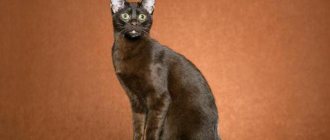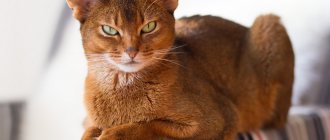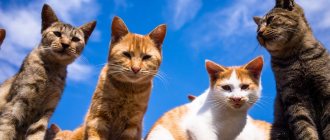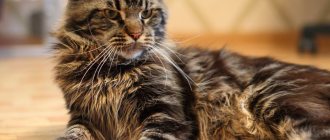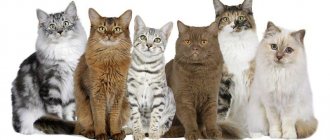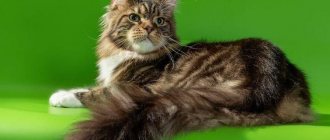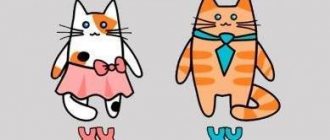According to the English writer George Mikish, people have dogs, and people have cats, apparently classifying them as useful pets. A joke, you say, but, as they say, there is some truth in every joke. Yes, these pets are more independent, characterful and even somewhat arrogant than dogs. But this not only scares people away from them, but makes them respect, love and appreciate them even more. In addition, different breeds have their own characteristics that must be taken into account when choosing your pet.
Shorthair cats
Abyssinian cat
Representatives of the ancient breed, which were depicted next to the pharaohs, definitely attract attention. Their grace, royal posture and confident look leave no doubt that they were once truly considered sacred. Despite its proud appearance, the Abyssinian cat is very playful, active and extremely curious. She can show character because she doesn’t like to be held. But the Abyssinian gets along quite well with other pets, as well as with children.
American Shorthair Curl
A cat with average proportions and characteristics, but distinguished by amazingly shaped ears. They seem to be turned outward, and curl owners joke - so as not to miss a sound. There are several varieties of American Curls with coats of varying lengths, but they all have the longhair gene, and fluffy kittens can also appear in the smooth-haired family. The fur coat of cats is silky, soft and lacks undercoat.
As for character, they are distinguished by intelligence, playfulness and obedience. Raising them will not cause any difficulties, because these cats can even be walked on a leash.
Asherah
A cat shrouded in mystery, arousing interest and attracting more and more people who want to buy it, regardless of the cosmic price. This is the only cat that has gained popularity without being recognized as a separate breed. According to the authors of the breed, this is the result of crossing cats - Asian leopard and domestic, as well as serval. But skeptics are sure that Ashera is nothing more than a type of savannah.
But, be that as it may, these are graceful, large cats, whose weight can reach 14-15 kg. Outwardly, they are very reminiscent of a leopard. Like all cats, they are curious, playful and great with children.
Bengal cat
An explosive mixture of temperamental wild leopards and docile domestic cats, however, the Bengal cat took only the best qualities from both of them. Her intelligent, graceful appearance and leopard print color immediately catches your eye.
Moreover, from its wild ancestors the cat also inherited a voice ranging from a gentle purr to a roar, and a love of water. Bengals love to communicate, play and are very active. Loneliness is not for them; you won’t be bored with such a pet.
Bombay cat
A graceful cat with satiny black fur and a graceful physique, beautiful, with a touch of exoticism and mysticism, this is the Bombay cat. Representatives of the breed attract not only their chic appearance, but also their noble origin, balanced temperament and unpretentiousness. Even if a cat gets angry, she will not rush into battle; it is easier for her to hide from everyone and recover in silence.
It can be kept in company with other animals. A cat, showing tact and restraint, will be able to improve relationships, but not without showing leadership. She is highly adaptable to new conditions and calmly treats both adults and children.
British Shorthair
Powerful, well-developed animals with pleasant plush fur have long gained popularity. They are very colorful, have a serious appearance and a character to match. They have all the classic cat habits, but in moderation - curiosity, independence, friendliness and playfulness.
Owners note that the British Shorthair cat will never completely obey its owner, valuing its own freedom and territory. This can also be called a plus, because such a pet can go without the attention of the owner for a long time and not bother with its presence.
Burma (Burmese cat)
These are representatives of an ancient breed, the Burmese were depicted in temples and worshiped. Today the cat is not only popular among hobbyists, but also among breeders. Thanks to their attention, two types of breed appeared - European, with a triangular muzzle, and American, with a more rounded muzzle.
One of the advantages of cats of this breed is their silky coat, which is very sensitive to external temperature and can even change shade. As for character, this pet is very playful and suitable for families with children. After all, even in the midst of a game, the Burmese will not use its claws and teeth. She does not remember the insult and always remains friendly.
Burmilla
This is the result of breeding work for which the Burmese cat and Persian chinchilla were used. The cat received the muscular body of a Burmese and beautiful fur from a Persian. Burmillas are very sociable animals, they can listen to their owner and even relieve stress.
They have a hard time with loneliness, love to be with their family and get along well with all members - people and animals. These cats have another quality that causes affection - they can smile.
Devon Rex
This is a relatively young breed, its representatives have a slightly fabulous appearance. They have a triangular muzzle with huge saucer eyes and large ears. Their main property is a meaningful and very piercing gaze.
The Devon Rex is a true companion, because the pet will follow on your heels, participating in any activity. Representatives of this breed are playful, curious and sociable. If you need a cat that will walk “on its own,” then the Devon Rex is not suitable.
Egyptian Mau
The history of the breed goes back centuries, and its age is over 3000 years. Moreover, during this time its representatives have remained virtually unchanged. The Egyptian Mau has the beautiful coloring and grace of a wild cat, but its sociability and need for attention makes it a completely domestic animal.
They have a hard time with loneliness and can even be intrusive, demanding affection. Otherwise, Mau are no different from other cats - they love to play, are curious and very smart.
Korat
Not a very common cat breed, however, worthy of attention. This is a Thai cat with a blue coat and expressive eyes - orange or amber. Their characteristic quality is affection for their family. They are ready to follow along, showing interest in any processes.
They are also very playful; if you don’t give them special toys, they will find something to occupy themselves with. Korats do not get along with other cats, showing a clear sense of ownership. They will not tolerate other favorites and will be very jealous.
Cornish Rex
Graceful cats with exotic curly hair have already won the love of many. They are stately, have high paws and a light body - real aristocrats. Their silky coat is often compared to astrakhan fur - it is soft and pleasant to the touch.
Cornish Rex owners are unanimous - pets have many advantages. They are intelligent, clean, smart and love not the house, but their owner, naturally, the latter cannot help but bribe.
Lykoi
Werewolf cats, werewolves, catwolves - there are so many names for really strange representatives of this breed. They became an accidental result of breeding work, but were nevertheless recognized and received the name - lykoi. Cats have no fur around the nose and eyes, graying hair and bright yellow eyes, which add mysticism to the animal.
But their appearance does not prevent them from being sweet and friendly; cats love to be the center of attention and sometimes require affection. They can get along with cats and dogs, but small animals and birds will be perceived as prey.
Munchkin
Cats of this breed are called dachshunds or basset hounds because of their low stance. And, indeed, the munchkin actually has excessively short legs. But this physiological feature does not affect the health of the animal and otherwise it is an ordinary cat.
Of course, these cats cannot jump as high as their long-legged counterparts, but this does not detract from their playfulness and activity. Munchkins are similar in character to dogs; they do not mind walking with a harness, they are devoted to their family, and are sociable. But at the same time they are able to stand up for themselves.
Mekong Bobtail
These are the most beautiful cats - Asian aristocrats who once lived in temples and imperial chambers. Mekong Bobtails have amazing, crystal blue eyes, the look of which radiates universal calm, and, like other Bobtails, a short tail.
Asians are playful and even enjoy apporting; they do not release their claws during play. But they can bite if they feel that a person has crossed the border. Therefore, this is not the best option for young children. These cats can get along with other pets, but will definitely show their leadership qualities.
Oriental cat
This breed originated from Siamese cats, having adopted some qualities from them. They have an elongated, elongated muzzle, expressive, slightly squinted eyes and amazingly sized ears. The Oriental cat is very graceful, with long legs and a light body.
Representatives of this breed are not suitable for people who cannot pay enough attention to them. Orientals are trusting, loving, active and talkative. They happily greet their owner and do not hide their emotions.
Ocicat
Not a very common cat breed with wild colors and purely domestic ancestors. Ocicats are the result of crossing Abyssinians with Siamese. They have good physical development and average size. As for their character, they are very sociable, sociable and cheerful pets.
If the owner does not have time to pay attention to the Ocicat, then you can get out of the situation by getting another pet - a dog or a cat. The pet will be able to find a common language with the new family member and will be less bored. These cats tend to choose one owner, but at the same time communicate with everyone. They have a loud voice and are not averse to chatting.
Russian blue cat
Participants and favorites of exhibitions – these cats have long managed to win the love of breeders. They are beautiful, graceful and miniature, have a luxurious, silver-blue coat and emerald eyes. The Russian Blue cat is a true aristocrat who shows restraint and calmness, even if she is torn by curiosity. She will not impose her company, but is not averse to being with her owner.
It takes time to gain her trust, this applies to both people and other animals. The cat loves to explore new things and watch events happening. Therefore, they can often be found looking out the window or exploring all the nooks and crannies of their home.
Savannah
A very fashionable breed that attracts attention, because it is a large hybrid of a serval and a Siamese cat. Of course, the offspring of such love underwent a lot of changes and selection work, but the result justified itself. Savannah inherited the wild appearance and qualities of a domestic cat, but only after several generations.
The character of the savannah depends on how much wild blood flows in its veins. The less, the more flexible and trusting she is. Of course, the first litter of a serval and a cat will cost fabulous money, but it will be better to keep the pet in an enclosure. Subsequent crossings of offspring with domestic cats reduce the cost of kittens and make them more domesticated.
Siamese cat
Representatives of an ancient Thai breed, which were nicknamed “moon diamond” in their homeland. Due to its dark muzzle and paws (point), the Siamese is often confused with other cats, but it is distinguished by a more refined, narrowed muzzle, large ears and almond-shaped eyes.
The Siamese cat is very smart and not without willfulness. She loves to attract attention to her person, but she can easily tolerate 10-12 hours of loneliness. Claims that cats of this breed are angry and aggressive are not confirmed, since with proper care and good treatment they are excellent pets.
Snow shu
Amazing cats, whose name translates as “snow slippers,” are actually an oversight on the part of the breeder of Siamese cats. Not knowing who the father of the offspring with white socks was, the woman did not ignore this, and, continuing the selection work, identified the culprit; it turned out to be an American shorthair cat.
This is how these proud, not devoid of independence, Snowshoe cats appeared. They love water, sing and are trainable. Due to their beautiful appearance, these beauties are well suited for a show career.
Thai cat
Due to their external similarity, they are often confused with Siamese cats. The blood of the ancient Siamese flows in their veins, and the Thais themselves were known back in the 14th century. The Thai cat is very beautiful, she has a dark muzzle, against which her crystal blue eyes literally shine. But owners who have a Thai dog value its other qualities more - obedience, love, sharp mind and quick wit.
People are sure that if you take a Thai cat into your home, then later there will be no question of having pets of other breeds. In addition, there is a belief that a cat of this breed brings happiness and good luck to the house.
Toyger
Modern breeders are increasingly setting the goal of obtaining an affectionate, domestic cat with the appearance of its wild counterparts. So the toyger was the result of efforts to breed a cat with a tiger-like appearance. The cat turned out to be beautiful, stately, with a striped coat.
And, in addition, careful selection and selection made the pet’s character very attractive. The toyger is very affectionate, loving, balanced, such a cat is ideal for a family with children. The cat loves to communicate not only with its family, but also with guests.
Ural rex
These are unusual curly cats from the Urals, information about which appeared in the 40s of the last century. They immediately attracted the interest of breeders, who are still improving the breed. The curly coat gives the Ural Rex a funny and mischievous appearance.
But even more people who want to have such a pet are attracted by their amazing character. Cats of this breed are very tame, affectionate and loyal. They are unobtrusive, but can support you in difficult times, are patient with children's pranks and are very attentive. An ideal pet for a friendly family.
Scottish lop-eared
Another name for the breed is Scottish Fold, the representatives of which came from Scotland. Their peculiarity is interesting, curved and hanging ears. In addition, the Scottish Fold cat has a strong body, round eyes and thick, pleasant fur.
The pet has a very funny appearance that evokes positive emotions. This is especially noticeable when the pet shows curiosity. He is also an affectionate purr, kind and friendly. He will be happy to be with his family, but he can also find something to do alone.
Exotic Shorthair
Exotics, the abbreviated name for representatives of this breed, are the fruit of crossing American and Persian cats. But the breeders pursued the goal of getting an American female with a Persian color, and the result was a Persian female with short hair. Moreover, the exotic cat is similar in all respects to the Persian, except for the fur coat.
By nature, exotics are gentle purrs who love to sleep with their owner, sit in their arms and be caressed. Due to their phlegmatic nature, the breed is recommended for older people. Such cats provide comfort and a calm atmosphere, without fuss and dirty tricks.
Japanese Bobtail
The appearance of these cats is quite ordinary - medium size, short hair, they are compact and well built. But what gives them away is their uniqueness – a short, curved (twisted, straight or kinked) tail. It is like a fingerprint, since no two tails are the same.
They love to play, jump, purr or meow loudly, are noisy and chattering. The Japanese Bobtail does not like to sit idle and is constantly busy exploring everything around. But at the same time, cats of this breed are loyal to their owners and have good contact with children and other animals.
Hypoallergenic breeds
First, you need to understand that if a person is diagnosed with an allergy to wool, then no cat is suitable for him. Even completely hairless breeds have small hairs, particles of which can provoke a strong reaction.
However, there are animals that are less capable of triggering an immune reaction to fur. These include:
- All hairless breeds and numerous subspecies with the prefix rex. These cats have less fur. Axial hair does not often fall out and break, so it is less likely to enter the human respiratory tract.
- Siberian cats, despite their thick fur, are least likely to provoke a reaction to it. Most allergy sufferers do not notice the usual symptoms (tearing, itching, runny nose) when coming into contact with Siberians.
Also read the great article about hypoallergenic breeds.
Semi-longhair cats
Kurilian Bobtail
These are representatives of a semi-wild breed, the ancestors of which are considered to be the bobtail from Japan. These pets are called lynx cats, because in appearance they are very similar to them, and, in addition, they are adapted for life in a wild, harsh environment. Life on the Kuril Islands made the cats large, hardy and fearless, and crossing them with the Siberian cat had a fruitful effect on their character.
The Kurilian Bobtail is a large cat with a short tail and semi-long, dense hair; the claws of these cats do not retract; they love water very much. They become very attached to their owner and can even protect him, driving away strangers.
Maine Coon (Manx Raccoon)
Cats with lynx tufts on their ears and a raccoon tail, huge (for a domestic feline) size and expressive muzzle are the dream of many. Despite their somewhat wild appearance and size (males can reach 15 kg), these pets are affectionate, playful and sociable.
Of course, Maine Coons have a number of characteristics, for example, they like to get into the water, not all of them are tame, but all of them are “talkative”. They do not put out their claws unnecessarily and love to always be close to their owners, but do not interfere.
Somali cat
This breed is descended from Abyssinian cats, but is distinguished by semi-long hair throughout the body and longer hair in the neck, panties and tail. The peculiarity of Somali cats is their color, which alternates light and dark tones, capable of forming stripes. The more stripes a cat has, the higher its price.
Somalis are not couch cats and their playfulness does not fade with age. However, they are not destructive pets and usually do not cross boundaries. They are suitable for large, noisy families with children and other pets.
Turkish van
Representatives of this native breed are quite large, well-built and beautiful animals. Their peculiarity is a special “Van” color - a white coat with reddish-reddish spots in the area of the muzzle and tail; they are also allowed to be present on the back.
The Turkish Van is a very sociable cat, trainable and loves water treatments. She not only loves affection, but is ready to give her back at every opportunity. Representatives of this breed also need walking and feel great on a leash. Of course, they are still not dogs and it is enough for them to walk 1-2 times a week.
Mr. Cat advises: the cutest breed
The championship in terms of touching comments on social networks and the delight of people, young and old, undoubtedly belongs to munchkins. A random mutation that gave a cat incredibly short legs spread to her offspring.
The breed got its name from the tiny people who inhabited the magical land of OZ.
In addition to its funny appearance, this breed is distinguished by its friendliness, touching affection for its owners, affection and a lively, inquisitive mind.
Longhair
Burmese cat
Burma, as these cats are called for short, has the luxurious fur coat of the Persians and the original color of the Siamese. There are many legends and tales wandering around the breed and they are called “sacred”. It is difficult to say what is true and what is fiction, however, the Burmese are truly distinguished by their “holy” character.
They are playful, but not dirty, active, but in moderation. They do not impose their communication and agree to wait until the owner has time to communicate. The Burmese cat gets along with children, but does not like excessive noise and tense environments.
Neva Masquerade
They are called Siberians with Siamese sophistication; cats and cats of this breed are beautiful, large and very colorful. But this is by no means a merit of the efforts of the breeders, but the result of an accidental love between a Siberian cat and a cat with a Siamese color (it is not known for sure whether she was Siamese or Himalayan).
The Neva cat is a long-liver, its fur does not cause allergies and does not require painstaking care. She has a certain charisma - she loves to show off, but she is distrustful of strangers. Adapts perfectly to new conditions and loves his family.
Norwegian Forest Cat
Once upon a time, this large, colorful animal with long luxurious hair lived in the Norwegian forests. Naturally, this determined his hunting qualities and endurance, but selection work turned the cat into a cute domestic creature that retained high intelligence and beautiful appearance.
The Norwegian Forest cat is suitable for indoor keeping; it is very balanced and calm. He loves to communicate, but sometimes he doesn’t mind being alone. Finds a common language with other pets and is good with children.
Persian cat
Cats of this breed are hard to miss - after all, they have an extravagant appearance - a wide muzzle with a flattened nose and the most luxurious fur. The breed has undergone a number of changes, not always positive, but today it has no flaws, and its representatives are healthy and active.
The Persian cat is an ideal companion that does not like loneliness and is not suited to living on the street - only with a person does it feel calm and confident.
Ragdoll
A young amazing breed of cats that can completely relax all their muscles, which is why its name translates as rag doll. These are quite large animals with beautiful fur. Born with white fur, after a year and a half it acquires the most incredible colors.
Ragdolls are absolutely sociable cats; loneliness is difficult for them, and they are ready to follow their owner anywhere. They are phlegmatic, they love to lie around, but they also don’t mind playing, especially with children.
Siberian cat
This is a native breed of Siberia and is believed to have descended from wild forest cats. Stocky, large (cats weigh up to 12 kg), fluffy - cats of this breed cannot leave anyone indifferent.
The Siberian cat has a developed hunter instinct, therefore, even if it gets lost, the pet will not disappear and will be able to provide itself with food. This quality also helps rid the house of rodents. These pets are unpretentious in all aspects of life, intelligent, but somewhat reserved.
Turkish Angora
The Angora cat is snow-white (blue and black individuals are less common), a graceful beauty - with blue, greenish or different eyes. She is a regular participant in various exhibitions and is popular.
The Turkish Angora does not require special care, it is smart, intelligent, calm, gets along well with children, but can be “on its own” or overly sensitive.
Why a purebred pet?
Choosing a pet is not an easy task. Nowadays it has become popular to purchase purebred cats. Each breed is beautiful and graceful in its own way, plus, with such a cat you can take pride of place at the exhibition. But you shouldn’t judge a cat by its appearance, it should suit your style and lifestyle. The catalog contains a lot of useful information about animals: appearance, temperament, necessary care. Representatives of the Persian and Angora breeds require special care, but they are not so dependent on human interaction. Are you at home most of the time and want some fun? Buy a Siamese or Abyssinian cat. If you have small children at home, you need a pet with a lot of patience in order to withstand all this squeezing. A British or Scottish cat would be a good nanny.
Diversity of the cat world
The world of cats is diverse. They differ in color, eye shape, fur length, character and other equally important criteria. There are a large number of organizations involved in developing standards and registering breeds. How a relationship develops with a pet depends on the person. For a cat, the owner is the most adored person on earth; his betrayal will leave a scar on the animal’s soul. For humans, a cat is a healing salvation from depression and bad mood, a fluffy little ball that can warm the heart on the coldest evenings.
Hairless cats
Bambino
This is the fruit of crossing a short-legged munchkin and a hairless sphinx; it turned out to be squat and hairless. Representatives of the breed have a very touching, defenseless appearance, which is why they were named like small children - bambino. By the way, long-legged kittens may also appear in the litter of these cats.
These cats are not hunters, so they do not show aggression during play. This allows bambino to be kept in the same nest even with mice. They are gentle, affectionate and playful.
Don Sphynx
Representatives of the breed have a very exotic appearance, however, they were bred in Russia. Cats do not have fur, they are very elegant, but have developed muscles.
The Don Sphynx is very inquisitive, active, but not mischievous. He chooses one owner whom he adores. He finds a special approach to the rest - he knows who plays with him, who feeds him.
Canadian Sphynx
Folded and bald, however, having won love and reverence, the Canadian Sphynxes look very distinctive. They have warm, soft skin that is pleasant to touch.
As for their character, they are very gentle and devoted, are not jealous of other animals and are not aggressive. They have pride, so they will not humiliate themselves and beg for a treat. But they will definitely try to pull it off.
Peterbald (Petersburg Sphynx)
The birthplace of the breed is the northern capital, where hairless cats with a model appearance appeared. Short-haired Peterbalds may also be born, but in character they are not at all different from their hairless counterparts.
These cats will wake you up in the morning, take you to work and greet you joyfully. They are friendly to all family members, but the pets simply idolize the owner. The advantage is their cleanliness, the disadvantage is excessive “talkativeness”.
Best friend for a child
For a home with small children, it is worth choosing a cat with the most docile and gentle disposition, but with a strong constitution and the ability to support active games. Pets will help your baby learn responsibility and care.
For families with children, Scottish and British, Persians and exotics, Angoras with medium-length fur, Burmese and Orientals are best suited.
For allergy sufferers, the best pet would be the Canadian Sphynx.
For younger schoolchildren and teenagers, an ideal companion and friend would be a representative of the Maine Coon breed.
Read more in the article about the best cat breeds for children.
Features of hunting
A forest cat attacks a person only in extreme cases or when wounded.
The forest cat feeds on warm-blooded animals: calves of wild goats, young chamois, hares, rabbits, rats, mice and other rodents, as well as various birds.
The forest cat tracks its prey not so much by smell as by sight and hearing. In May or April, the female lays six blind cubs, placing them in a hollow, a rock crevice or some other secluded corner; in case of danger, she drags them to another, more reliable place.
In its behavior, the forest cat is very reminiscent of a domestic cat, just like the latter, it purrs in a good mood, opens its mouth in anger, arches its back and expresses its feelings by moving the tip of its tail.
In many, if not all, localities of the region of its distribution, the forest cat has become so mixed with the feral domestic cat that it becomes doubtful whether it is still preserved anywhere in its original purity.
According to some researchers, the forest cat generally evolved from the wild domestic cat, but this view is unlikely to have any basis.
Persian
A cat with erect ears of small size is a Persian, a very beautiful breed, the history of whose origin has not yet been definitively revealed. Some scientists attribute to her a family connection with steppe cats, wild inhabitants of Asia, others believe that the direct ancestor of the Persians is the Pallas cat, which is also characterized by miniature ears. The distinctive features of the breed are :
- The body is large, with low legs, a muscular chest and developed shoulders.
- Medium sized fluffy tail.
- Wide set ears.
- Small snub nose.
- The average weight of an adult animal is about 7 kg.
- The coat is very long, more than 10 cm, thick but thin. A tuft of hair is most often present between the claws.
The owner of such a beautiful animal should prepare himself for daily care of long hair, otherwise it will mat and the cat will look sloppy. However, as an alternative, you could consider purchasing an Exotic Persian, an attractive breed with a soft, plush, short coat.
© shutterstock
This is interesting: Which drops are best for kittens against fleas
Care Tips
Smooth-haired cats are not very picky.
- It is enough to comb them once a week, and to maintain the coat in good condition, you can use a special conditioner.
- Curly-haired cats should not be bathed too often, and immediately after water procedures they should not be combed.
- A suede cloth is suitable for smoothing hairs.
- As for plush cats, remove dead hair once or twice a week using a rubber brush or a special silicone glove.
Lifestyle and nutrition
With approximately 40 species of cats, with the exception of Australia, cats are represented in all parts of the world. However, cats do not go as far north as bears and dogs, and are completely absent from Iceland and Madagascar.
Most large species are characteristic of predominantly tropical and subtropical countries. Apart from our domestic cat, which helps us in many ways to understand the nature of these animals, all cats eat exclusively meat. Video about the forest cat:
Most of them eat only freshly killed prey, and only those forced by hunger resort to carrion. They attack their prey suddenly, having previously approached it with great caution. All cats hunt alone, with the exception of lions.
Spreading
The family and genus of cats are represented in most countries of Central Europe by only one wild cat (F. catus). In this species, the tail barely reaches half the length of the body, is of equal thickness throughout, is covered with hair evenly throughout, ends bluntly and is 32 centimeters long.
The body length of a forest cat varies between 70 and 90, and the height at the scruff of the neck is between 35-42 centimeters. The fur is brownish-gray, with blackish transverse stripes, the inner thighs and belly are whitish, the crown has black longitudinal stripes, the throat has a yellowish-white spot, the tail has black rings and a black tip. The wild cat is native to Central and Southern Europe, beyond which it spreads not far.
To this day, the cat is occasionally found in the wooded areas of Scotland, Northern and Western England, Ireland, France, Germany, Poland, Hungary, Spain, Italy, Greece, Turkey, the Caucasus and Transcaucasia, where it was found in Georgia.
It prefers to live in vast mountain forests and especially prefers coniferous trees. So, it is still quite common in the Harz and the Alps, but most often in the uninhabited forests of the Carpathians. From these mountain forests, the forest cat descends into the valleys if it finds more or less continuous forest spaces in them, and often moves several days away from its real places of residence.
Maine Coon
It is this breed that first comes to mind when it comes to large cats. After all, its representatives are now at the peak of their popularity, reaching a weight of 8 kg and a height at the withers of up to 40 cm.
It is believed that Maine Coons appeared in North America as a result of crossing wild American cats and individuals brought to the continent from the Old World. Representatives of the species spread especially widely in Maine, where they became favorites of farmers, helping to protect crops and grain barns from rodents.
The emergence of felinologists in Russia
Felinology is a science (a branch of zoology) that deals exclusively with domestic cats. The main directions of felinology are usually the structure of different breeds of cats, the specificity of their breed characteristics and the features of selection.
Science dates back to 1871, when Harrison Ware held the first exhibition of purebred cats in England. It was then that the standards of some breeds were first described. And 6 years later (in 1887), Ware registered the British Cat Lovers Club and appointed himself president. In world history, the movement of felinologists began with the National Cat Club.
Before moving on to Russian felinological organizations, you need to understand what tasks felinologists generally set for themselves (regardless of their country of residence). Today, as over the last century, felinological organizations set themselves the following work tasks:
- elaboration of all the subtleties of breed standards;
- bringing breed characteristics to perfection;
- systematization of cat shows and regulation of the approach to holding exhibitions;
- standardization of breed registration rules;
- regulation of the activities of nurseries and clubs;
- development of rules for the work of expert felinologists;
- supervision of the work of nurseries and clubs.
Conventionally, all international felinological organizations can be divided according to the principle of operation into two systems:
- the European system usually unites small and large clubs of cat lovers;
- The American system involves the association of owners of professional nurseries.
It is worth noting that felinological organizations in Russia work primarily according to European principles.
One of the most popular breeds in northern countries, the Siberian cat, is distinguished by thick, warm fur and a gentle character.
